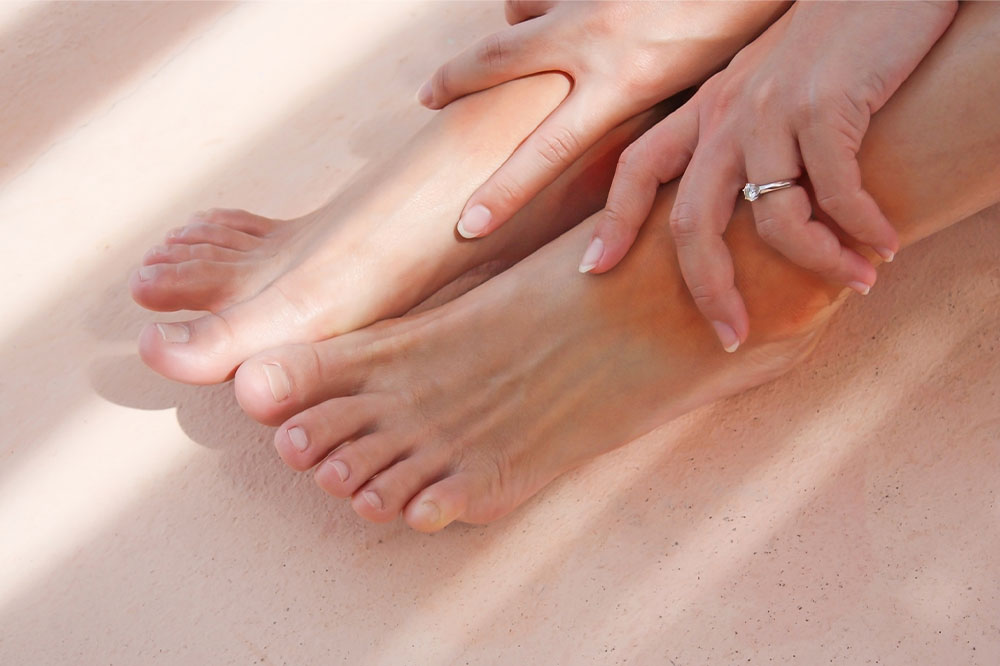9 warning signs of poor blood circulation

Poor blood circulation is responsible for reducing the blood flow to the various organs and muscles, which can cause severe complications in individuals. This condition develops when the circulatory system cannot pump blood effectively to various body parts, leading to low oxygen levels and nutrient deficiency. This condition usually affects the hands and feet of an individual. Here are some warning signs of poor blood circulation in the body which you should be aware of.
Numbness in some body parts
Experiencing a numbing or tingling feeling in the hands and feet is a common sign of poor blood circulation. In addition, some individuals may also feel pins and needles in their extremities due to inadequate blood flow to the area. This sensation occurs when the restricted blood flow does not reach sufficient quantities.
Cold hands and feet
When the blood flow is low and does not reach the hands and legs, it can also make these body parts feel colder than the rest. This temperature fluctuation is an issue that affects not just the skin but also the nerve endings of the arms and legs. However, some other conditions can also lead to cold hands and feet, so always be aware of the symptoms thoroughly. The other illness could be Raynaud’s phenomenon, which is responsible for causing the coldness in these body parts.
Swelling in the lower extremities
Due to poor circulation in the body, there can also be an accumulation of fluid in some parts of the body. This swelling caused by this fluid accumulation is called edema, often experienced in the feet, ankles, and legs. Some of the symptoms of this phenomenon include stiff joints, pain in the affected areas, heaviness and swelling in the area, and tight, warm skin. This condition can also occur when the blood collects in these affected areas like hands and feet, and when the pressure builds inside the blood vessels, the fluid is forced to leak into the surrounding tissues.
However, edema can also be a warning sign of heart failure because the heart is responsible for adequate blood supply and circulation. When the heart is unable to circulate this blood, edema can develop.
Stomach issues
Proper blood flow is crucial for digestion, and gastrointestinal problems have been associated with poor circulation. Some stomach issues resulting from inadequate blood flow include diarrhea, abdominal pain, cramping, bloody stools, and constipatioIt’st’s essential to take note of these symptoms as they can lead to further complications affecting other organs and overall health.
Fatigue
Research has shown that inadequate blood flow and circulation can negatively affect physical and mental health. Chronic fatigue and muscle weakness are the physical symptoms of poor blood flow. In addition, mental fatigue can occur due to poor blood flow in the brain during strenuous activities throughout the day, which can leave the brain tired. When the brain is deprived of nutrient-rich blood, lethargy can quickly set in. Therefore, avoiding these complications is critical.
Muscle pain
Joint pain and muscle cramps are other common symptoms that affect this health condition. Due to poor blood circulation, there can be pain experienced in the hands, feet, arms, and legs. Since the extremities also suffer through a temperature change, so when there is warm blood flow through the muscles, they can also ache or throb, or cramp because of the sudden temperature change. Also, it must be noted that when the blood is not circulating properly, the nutrients and oxygen cannot reach the tissues and muscles, leading to cramping and stiffness.
Leg ulcers
One of the essential functions of excellent and healthy blood circulation is to help heal the body from illnesses, wounds, and so on. With reduced healing capacity due to poor flow, leg, and foot ulcers are a common symptom. These ulcers usually develop when the blood collects or pools in the veins of the legs. This can cause swelling beneath the skin and lead to ulcers on the skin of these body parts.
Varicose veins
This is a common problem regarding poor blood circulation and is often easily visible. These varicose veins make it difficult for the blood to circulate back to the heart leading to potential blood pooling in the extremities. This blood pooling or clotting can lead to issues like swelling in the legs, aches in the legs, heaviness, itchiness, and the appearance of knotting in the veins. These veins are a common side effect for anyone who stands for long periods.
Change in skin color
Another symptom to look out for is poor blood circulation, including a change in skin color. This means that the skin usually looks paler than its natural color. If blood leaks from the capillaries, these areas can also appear purple. Some body parts that may observe change in skin color include the ears, lips, nose, hands, feet, and nipples. These are some easy signs and symptoms to notice which indicate a problem with the blood flow, so proper diagnosis and intervention are needed to prevent any other health complications that may occur.
Usually, the treatment and management of poor circulation will depend on the cause of this condition. Sickle cell anemia is a condition in which the cells have a shorter lifespan which also means that the affected cells can clog up the blood vessels leading to poor circulation. There are some support groups to help through such illnesses and diseases, like Sickle Cell Disease Association of Children’shildren’s Sickle Cell Foundation, Sickle Cell Community Consortium, and so on.
Also, following a healthy meal plan and having an active lifestyle is imperative. Including plenty of greens, fruits, and resourceful food items in your meals can do wonders. Exercising regularly for a minimum of thirty minutes is also recommended to keep severe health conditions at bay.

